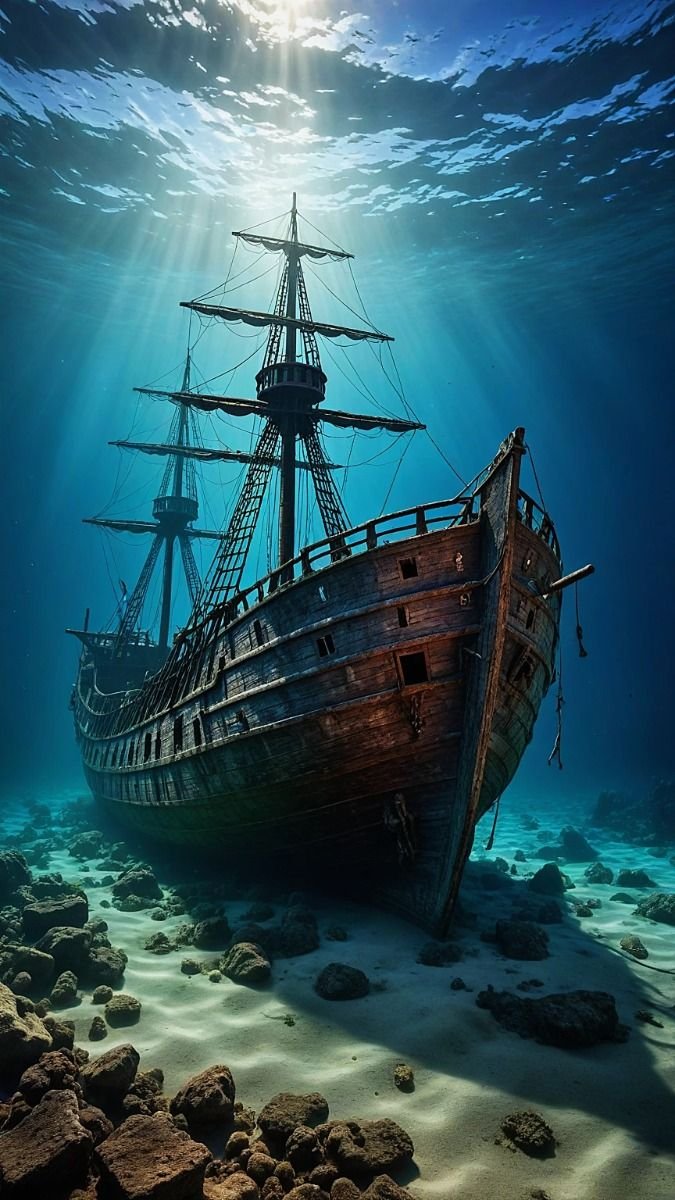Introduction: The Allure of Lost Ships
Shipwrecks are windows into history, frozen in time beneath the sea. Each sunken vessel tells a story of adventure, tragedy, and discovery. From mighty warships to opulent passenger liners, shipwrecks have become more than graves of the past—they are museums of the ocean floor. Over centuries, divers, historians, and treasure hunters have sought to uncover these underwater time capsules, revealing not only riches but also insights into human ingenuity and the perils of seafaring.
The Titanic: The Unsinkable Ship That Sank
Perhaps the most famous shipwreck in history, the RMS Titanic remains a haunting symbol of hubris and tragedy. Launched in 1912 as the largest passenger liner of its time, the Titanic was deemed “unsinkable.” Yet, on its maiden voyage, it struck an iceberg in the North Atlantic and sank, claiming the lives of over 1,500 passengers and crew. The wreck was discovered in 1985, lying more than two miles beneath the ocean surface. Exploration of the site has revealed poignant relics—shoes, dinner plates, chandeliers—reminders of lives interrupted. Today, the Titanic is both a cautionary tale of overconfidence in technology and a powerful memorial to human loss.
The Spanish Galleons: Treasure Ships of the New World
During the 16th and 17th centuries, Spanish galleons sailed the oceans laden with gold, silver, and jewels from the Americas. Many never completed their journeys, succumbing to storms, piracy, or naval battles. Shipwrecks like the Nuestra Señora de Atocha, which sank in 1622 off the Florida Keys, are legendary. Discovered in 1985 by treasure hunter Mel Fisher, the Atocha yielded one of the richest hauls ever found—gold bars, emeralds, silver coins, and priceless artifacts. These galleons represent the age of empires, where wealth flowed across the seas but was constantly at risk of being claimed by the ocean.
The Lusitania: Catalyst of War
Another tragic shipwreck etched in history is the RMS Lusitania. A British ocean liner, the Lusitania was sunk by a German U-boat in 1915 during World War I, killing nearly 1,200 people. The event shocked the world and contributed to the United States entering the war. Today, the wreck lies off the coast of Ireland, its corroding hull still a reminder of wartime horrors. The Lusitania’s sinking underscored how the sea, once thought of as merely a trade route, had become a battlefield where civilian lives could be caught in geopolitical struggles.
The Mary Rose: Tudor England’s Lost Warship
The Mary Rose, a pride of King Henry VIII’s navy, sank in 1545 during a battle with the French in the Solent, near Portsmouth, England. For centuries, it lay buried in silt, preserving thousands of artifacts—from weapons and tools to clothing and even musical instruments. In 1982, the ship was famously raised from the seabed and is now displayed in a museum, offering a vivid glimpse into Tudor life. The Mary Rose remains one of the most important maritime archaeological discoveries in Europe.
The Vasa: Sweden’s Sunken Giant
Like the Mary Rose, Sweden’s Vasa warship also suffered a dramatic and humiliating fate. Launched in 1628, the Vasa sank just minutes into its maiden voyage, top-heavy and unstable. For over 300 years it rested at the bottom of Stockholm Harbor until it was raised in 1961. Remarkably well-preserved, the Vasa is now housed in the Vasa Museum, attracting millions of visitors. This shipwreck is a reminder of the dangers of flawed design and the limits of early naval engineering.
The Andrea Doria: The Titanic of the Mediterranean
The SS Andrea Doria, an Italian luxury liner, collided with the Swedish ship MS Stockholm in 1956 off the coast of Nantucket, Massachusetts. Though most passengers survived, 46 lives were lost, and the Andrea Doria sank the next morning. Dubbed the “Titanic of the Mediterranean,” the wreck sits at a depth of about 240 feet and has become a popular, though dangerous, dive site. Its remains still hold artifacts and serve as a chilling reminder that even in the modern age, the sea can claim vessels thought to be safe.
The Edmund Fitzgerald: A Freshwater Tragedy
Not all famous shipwrecks lie in the ocean. The SS Edmund Fitzgerald, a Great Lakes freighter, sank in 1975 during a storm on Lake Superior, taking 29 crew members with it. Immortalized in Gordon Lightfoot’s ballad “The Wreck of the Edmund Fitzgerald,” the tragedy remains one of the most haunting maritime disasters in North America. The wreck lies broken on the lakebed, still sparking debates about what caused the sinking—rogue waves, structural failure, or human error.
The Antikythera Shipwreck: Technology Lost and Found
Discovered off the coast of Greece in 1900, the Antikythera wreck dates back to the 1st century BCE. It is most famous for yielding the Antikythera mechanism, often called the world’s first computer. This intricate device of gears and dials could predict eclipses and track celestial movements. Alongside statues and pottery, this discovery revealed how advanced ancient technology truly was. The Antikythera wreck remains a symbol of the treasures of knowledge hidden beneath the waves.
Shipwrecks as Underwater Museums
Today, shipwrecks serve not only as historical treasures but also as ecosystems. Sunken ships often become artificial reefs, attracting marine life and divers alike. While treasure hunters once sought gold and jewels, modern marine archaeologists value these wrecks for the stories they tell. Each shipwreck provides evidence of craftsmanship, trade, warfare, and culture, piecing together a broader narrative of human history. Yet, the balance between preservation and exploitation remains delicate, as some wrecks risk looting and damage.
The Eternal Fascination of Shipwrecks
Why do shipwrecks continue to captivate us? Perhaps it is because they combine human drama with the mystery of the deep sea. They remind us of our vulnerability against nature’s forces and the risks taken in pursuit of discovery, trade, and adventure. From the opulence of the Titanic to the innovation of the Antikythera, shipwrecks connect us to our past in a way few other relics can. They are time capsules, sealed in saltwater, waiting to share their secrets with those brave enough to uncover them.
Conclusion: Guardians of History Beneath the Waves
The world’s most famous shipwrecks are more than stories of disaster—they are guardians of history, preserving moments when human ambition met the unforgiving sea. Whether laden with treasure, technology, or tragedy, these wrecks remind us of the power of the ocean and the resilience of human exploration. As technology advances, more shipwrecks will likely be found, continuing the endless dialogue between humanity and the sea.


